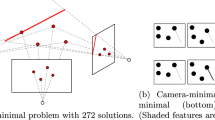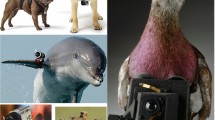Abstract
Rother and Carlsson introduced the Direct Reference Plane method for obtaining a projective reconstruction from a multi-view system, presuming the availability of a planar reference quadrangle in each view. In this method feature points and camera centres are obtained simultaneously by solving a system of homogeneous linear equations. Each feature-camera visibility pair corresponds to two equations in this system. In this paper we derive a count criterion for characterizing sufficient visibility, yielding a system of linearly independent equations that “determines” feature points and camera centres. Finally we discuss some principles to extend the configuration of feature points and camera centres while maintaining sufficient visibility.
Similar content being viewed by others
References
Carlsson, S. 1995. Duality of reconstruction and positioning from projective views. In IEEE Workshop on Representation of Visual Scenes. P. Anandan (Ed.).
Faugeras, O. 1993. Three-Dimensional Computer Vision. A Geometric Viewpoint. MIT Press, Cambridge.
Irani, M., Anandan, P., and Weinshall, D. 1998. From reference frames to reference planes: Multi-view parallax geometry and applications. European Conference on Computer Vision, 2: 829–845.
Nash-Williams, C.St.J. 1961. Edge-disjoint spanning trees of finite graphs. Journal of the London Mathematical Society, 2(36): 445–450.
Rother, C. 2003. Multi-View Reconstruction and Camera Recovery Using a Real or Virtual Reference Plane. PhD thesis, KTH, Stockholm, Sweden.
Rother, C. and Carlsson, S. 2002. Linear multi view reconstruction and camera recovery using a reference plane. International Journal of Computer Vision, 2/3(49): 117–141.
Tutte, W.T. 1961. On the problem of decomposing a graph into n connected factors. Journal of the London Mathematical Society, 2(36): 221–230.
Welsh, D.J.A. 1976. Matroid Theory. Academic Press, London.
White, N. 1986. Theory of Matroids. Cambridge University Press.
White, N. and Whiteley, W. 1987. The algebraic geometry of motions of bar-andbody frameworks. SIAM J. Algebraic Discrete Methods, 8(1): 1–32.
Whiteley, W. 1987. Parallel redrawing of configurations in 3-space. Research note, Department of Mathematics and Statistics, York University.
Whiteley, W. 1988. The union of matroids and the rigidity of frameworks. SIAM J. Disc. Math. 1(2): 237–255.
Author information
Authors and Affiliations
Corresponding author
Additional information
First online version published in February, 2006
Rights and permissions
About this article
Cite this article
Penne, R. The Characterization of Sufficient Visibility in the Direct Reference Plane Approach for Multiple Views with Missing Data. Int J Comput Vision 67, 5–20 (2006). https://doi.org/10.1007/s11263-006-4330-0
Received:
Revised:
Accepted:
Issue Date:
DOI: https://doi.org/10.1007/s11263-006-4330-0




